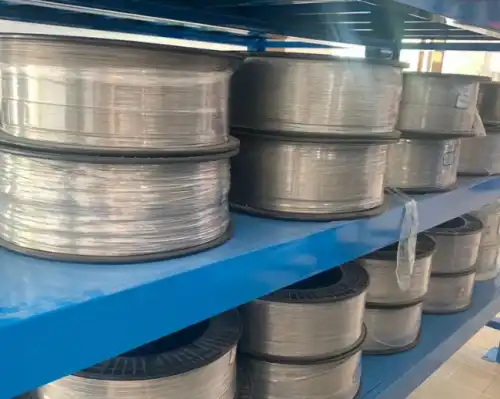The Rolling process of titanium wire and titanium alloy wire is one of the important technologies in the field of metal processing, which takes titanium and titanium alloy wire blanks as raw materials, and produces a variety of specifications into a disk or a single wire products through precise drawing process. These titanium wire products are widely used in aerospace, instrumentation, the electronic industry corrosion-resistant materials, and other fields, showing their excellent performance and wide applicability.

Raw material and product application
Raw Materials: Titanium and titanium alloy wire blanks, including but not limited to industrially pure titanium, Ti-15Mo alloy, Ti-15Ta alloy, Ti-3Al, Ti-6Al-4V, and other compositions, which are supplied either in reels or as single rods.
Product application: Titanium iodide wire: is used in precision instruments, electronic components, and other high-end fields.
Ti-15Mo alloy wire: as the suction source material of vacuum titanium ion pump, it plays a key role in the field of vacuum technology.
Ti-15Ta alloy wire: an important suction material in the vacuum industry sector.
Industrial pure titanium and other titanium alloy wires: widely used in corrosion-resistant parts, electrode materials, welding materials, etc. Some high-strength titanium alloys such as TB2 and TB3 are specialized in the aerospace industry.
Key Technical Parameters
Heating regime and final rolling temperature:
β-type titanium alloys: the heating temperature before rolling needs to be slightly lower than the (α+β)/β phase transition temperature to ensure that the titanium wire rolling process is completed in the α+β phase region.
α-type titanium alloys: the heating process is carried out in the α+β phase region.
α+β type titanium alloys: the heating temperature is higher than the β transition temperature to ensure that the material is sufficiently softened for rolling. The heating time is based on the thickness of the material, usually calculated at 1~1.5mm/min.
Rolling speed: Because of the large demand for titanium and titanium alloy rolled profiles and the length of the product needs to be maintained, the rolling speed is generally controlled at 1 ~ 3m / s, to avoid quality problems caused by excessive speed.
Roll hole design: according to the titanium alloy's deformation resistance, widespread value elongation, and other characteristics, select or design a suitable roll hole type. For mass-produced titanium alloy profiles, special roll hole patterns for titanium alloys can be designed to optimize rolling efficiency and product quality.
Process optimization and prospects
With the progress of science and technology and changes in market demand, the titanium wire rolling process is also constantly optimized and innovative. In the future, it can be expected that the following areas will make further breakthroughs:
Improvement of heating technology: Adopt more efficient heating equipment and more precise temperature control technology to reduce energy consumption and improve heating uniformity.
Improvement of rolling speed: Under the premise of guaranteeing product quality, the rolling speed will be improved by optimizing the rolling process and equipment performance, to enhance the production efficiency.
Intelligent production: the introduction of automation and intelligent technology to realize the titanium wire rolling process of remote monitoring and intelligent control, improving the stability and reliability of the production process.
In summary, the titanium wire rolling process is one of the important technologies in the field of metal processing, the precise control of its process parameters, the continuous upgrading of rolling equipment, and the promotion of intelligent production will provide strong support for the wide application of titanium wire and titanium alloy wire.











